#Sewing hack
Explore tagged Tumblr posts
Text


I’ve reorganised my sewing needles using spare blood tubes from the hospital! It is such a great way of storing needles because:
1. I can stab them into the rubber thingy at the top so they stay organised and I don’t need to tip them out into my hand (the rubber is thick enough that they don’t poke out the other side)
2. They stay sealed in the container with anti-moisture beads so that they don’t go rusty
3. I can colour-code the tube lids depending on what is in them
So next time you are in your local emergency department, ask one of the doctors or nurses if you can steal some spare blood tubes!
#projects#hand sewing#handmade#sewing#needles#sewing needles#blood draw#blood test#test tubes#hand sewn#hand embroidery#hand quilting#craft hack#sewing hack#life hacks#craft storage#sewing storage#sewers want me#doctors fear me
17 notes
·
View notes
Text
Faux Shirring Hack: How to Create Stunning Shirred Dresses with Just an Elastic Band
In this post, you will learn faux shirring hack to create dresses without the need of a zipper. Have you ever admired those shirred dresses that look so chic and comfortable, but thought they were too complicated or expensive to make? Well, you’re in luck, because in this faux shirring tutorial, I will show you how to create your own shirred dresses with just an elastic band and some…
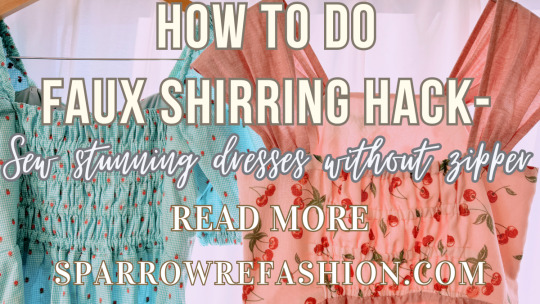
View On WordPress
#Elastic band#Faux shirring#Faux shirring dress#Faux shirring fabric#Faux shirring hack#Faux shirring sewing machine#Faux shirring technique#Faux shirring tutorial#How to do faux shirring#Sewing hack#sewing tutorial
24 notes
·
View notes
Text

I highly recommend you remove your Selvage from your fabric before measuring and cutting your pieces. I see a lot of quilters in videos leaving their selvage on, however, the selvage is woven differently than the rest of the fabric so it will shrink at a different rate causing puckering in your quilt after it’s washed.
However, there are several ways you can use the selvage so you are not wasting the fabric. You want to cut about 1-2″ from the edge so you can see the selvage and a piece of its pretty fabric.
You can make a Scrappy Quilt or a a String Quilt using Selvages. You can also think beyond quilting and work them into sewing projects like bags, pillows and pin cushions.
Prep Well: An easy way to get your selvages sew-ready is to starch and press. Otherwise, your selvages can be pretty wavy and tricky to work with.
#crafts#gifts#decor#sewing#quilting#briar rose quilts#bedding#shopping#quilters of tumblr#fabric#selvage#fabric selvage#fabric scraps#scrappy quilt#quilt#string quilt#pillow#bags#sewing hack#sewing tip
1 note
·
View note
Text
youtube
That part at 4:04
Was I suppost to learn this technique of tranferring markings to several layers of fabric from a random youtube video? How have I never seen this before? How did I not come up with this?
And how sad it is that the trade of tailoring is reduced to suitjackets?
0 notes
Note
I first heard about them in the context of leaders-and-enders quilts.
It seems like a fun way to get a quilt done if you have other sewing to do, or if you want a simple-ish pattern done, but... There's that deliciously brain-tickling one that's right there, tempting you.
Edit: tumblr ate the link.
while watching your video on making shirts i noticed you had a piece of black fabric with a bunch of different threads sewn in it. i was wondering what the purpose of this was. is it to help reduce thread waste?
Partly that, but more so that I don't have to deal with thread tails on pieces where I'm starting right from the edge, and to prevent the machine from sucking them in and making a big snarl.
#quilting#sewing#leaders and enders#spider#chain piecing#it's not cheating if you can call it a specialist technique#project management#sewing hack
340 notes
·
View notes
Text
Life Hack: Clothing Repair 🤔
#pay attention#educate yourselves#educate yourself#knowledge is power#reeducate yourself#reeducate yourselves#think about it#think for yourselves#think for yourself#do your homework#do your own research#do some research#ask yourself questions#question everything#life hacks#sewing#clothing repair#repair tips#diy#did you know
670 notes
·
View notes
Link
#sewing#slit neckline hack#overlapping neckline hack#trimmed neckline#T-tunic slit neck sewing hack#sewing hack
0 notes
Text

270 notes
·
View notes
Text
A little more quick sewing machine troublshooting:
If your machine is doing something you don't understand, engage your bobbin winder, and then disengage it.
This will probably not do anything. However, it's fast, it won't hurt anything, and a surprisingly large percentage of the time, it's actually the solution.
Notable cases: Baby Lock and Brother machines where the button turns orange. Janome machines where the LCD says "SP" or gives you a display that looks like "] [". Viking Emerald 118's where the button on the front stops working. Bernina machines where you turn it on and immediately hear a noise of a motor running. Mechanical machines where you step on the foot and hear the engine running but nothing is turning. Probably more, that's just what's in my head right now.
It's the solution rarely enough that you shouldn't expect it to fix it, but it's also the solution often enough that it should absolutely be part of your troubleshooting procedure. Go through the steps to engage your bobbin winder, make it turn for a couple rotations to make sure you've engaged it properly, and then disengage it.
It's worth a shot.
69 notes
·
View notes
Text
Sizing up a hoodie or sweatshirt
I had an old hoodie I wanted to wear more often, but it's always been a little snug (the price you pay when the merch table at a show has limited sizes remaining but you HAVE TO GET A SOUVENIR - and also support the band). I realized I had another hoodie I didn't wear very much, and decided to sacrifice it to size up the other!
The black stripe is the sacrificial hoodie bit, which overall made the original hoodie about 6 in larger all around (3 in strip added under each arm). Keep in mind, this method makes the torso larger, but also the sleeve size. I bet that's helpful to most people, but if you wanted to not size up the sleeve so much, you could probably cut your strip so it's narrower as it goes down the sleeve. But not to a fine point! Just a little narrower on one end than the other. You still need to have room to use your serger on both seams.
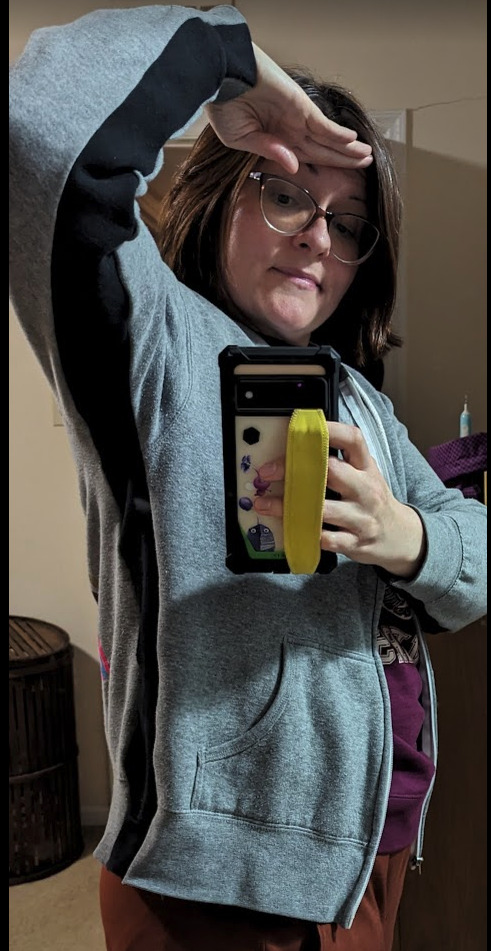
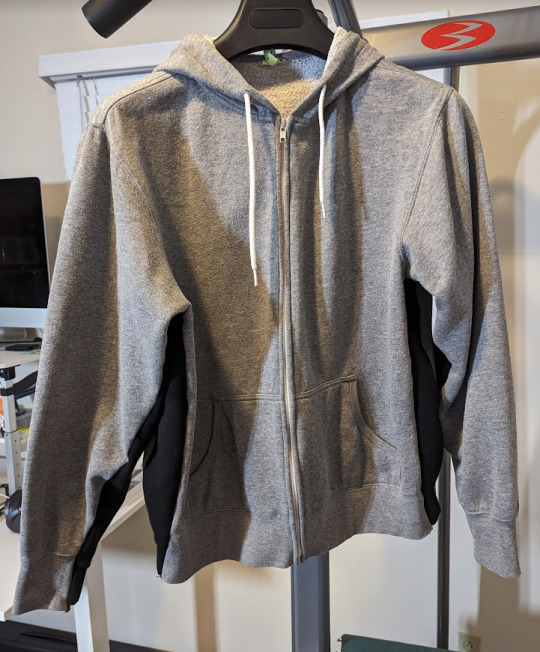

I looked up tips for adding a gusset under the arm. It was not an ideal solution; I ran into a pet peeve in my searching. When folks yadda-yadda over the fiddliest bit of the process. No! Please tell me how exactly you pivot around a point with a stretch stitch and then serge the rest of a seam!! I was not about to try to figure that out with no clear tips.
So, I decided to approach it with the skills and tools I was most confident using (not confident in my ability to use the right kind of stretch stitch around a corner at an armpit seam. I knew it would fall apart!).
NOTE: I used a serger for the entire process. I opt to use an embroidery needle or similar to pull the tail back up into a few stitches rather than try to sew over the tail ends. It's not as quick but I know it works and I have more control. I'm not going to cut into something by accident either!
ANOTHER NOTE: You HAVE TO use 2 sweatshirts or hoodies that are the same length from the pit to the BOTTOM HEM. If the length from the pit to the arm cuff hem is somewhat off, that's okay. When you're done, you could always cut off the cuffs and serge on a new one. But you can't so easily do that on the bottom hem on a hoodie with a zipper.
See how the cuff is misaligned here. I could cut off the cuff just above the grey seam and serge on a new strip of ribbed knit if I wanted it to look cleaner. But this was close enough, and also who wants to chop off its character? Someone who's probably no fun at parties, but probably better than me at filing their taxes, that's who.
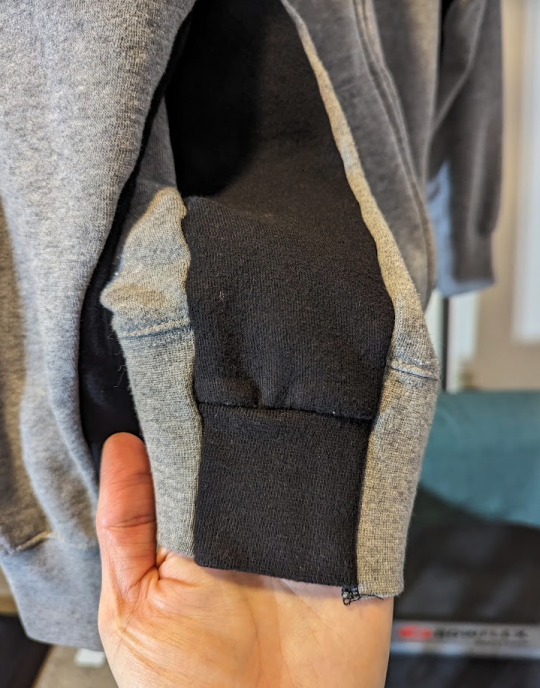
HOW I DID IT
I essentially added a strip from one hoodie into the under arm/side of the other. If you're wanting to be precise, you can measure how much extra room you want to add, divide by 2 and that's how much you'll harvest from your sacrificial hoodie. The serging will eat some from each seam; consider how much you are comfortable serging off and add that math in for yourself. This one was about 3" wide on each side, as I feel comfortable to serge with taking off just a whisper.
I used a marking tool and a ruler to mark a consistent 3" wide cutting line from hem to cuff on the black hoodie. You'll be cutting a straight strip so don't eyeball it! If you're making it a little smaller at one end than the other, an even better reason not to eyeball it!
You can only remove up to where you come in contact with a pocket, zipper, or other component. Pick up a hoodie and look under the arms and you'll see what I mean! Here's as far as I cut due to the location of the pocket on the black hoodie:
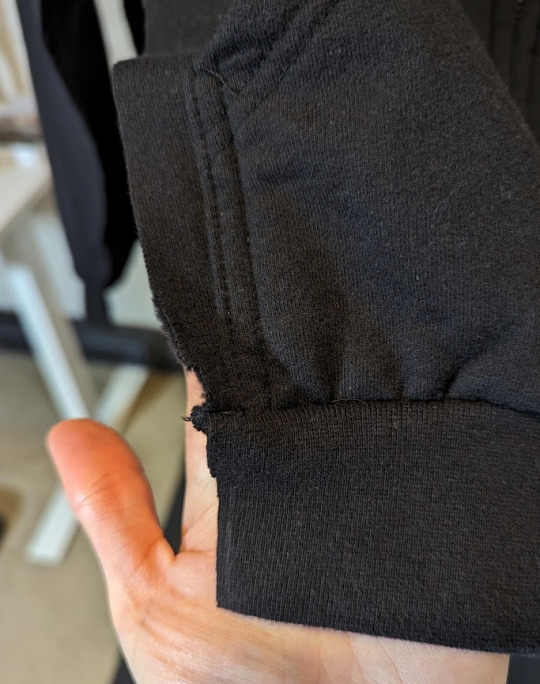
Here's what that black hoodie looked like after I cut out the strips. Daniel was quite amused by it looking like a pelt and/or some kind of punk wizard's cape:
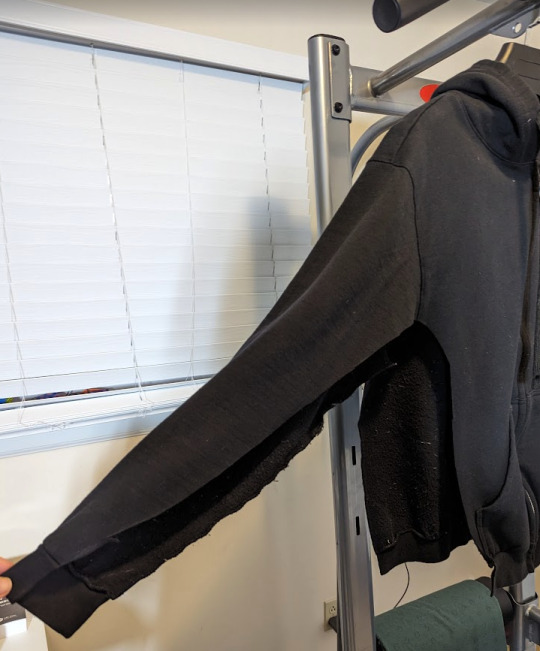
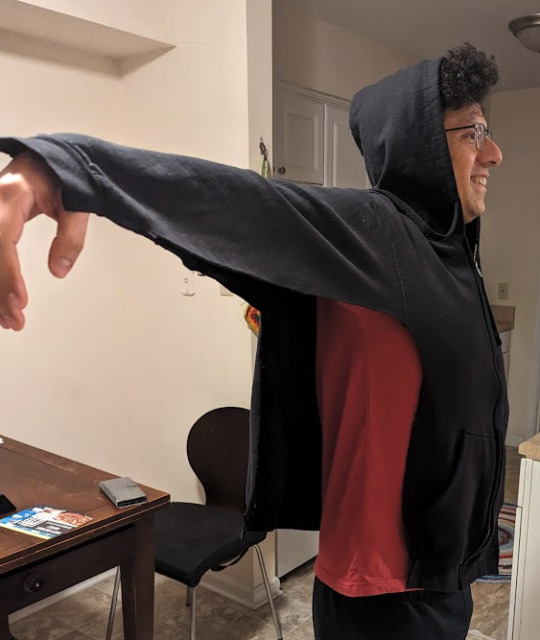

Mark which strip is meant for which side before you move on, so you don't get frustrated later! THIS IS IMPORTANT!
Next, you have to cut open the hoodie that will be gaining these strips. At first, I was carefully seam ripping the side seams but that is SILLY! Don't do that. Just cut it, your serger will be removing any old seam bits.
Right sides together, pin your strips in place. IMPORTANT! Make sure you're using the correct side of the old hoodie to the new one! R with R, L with L.
IMPORTANT ALSO!! Make sure the underarm pit seam intersection is aligned! Start pinning from there, and work your pinning out. AGAIN! the length from this pit junction to the bottom hem should be almost exactly the same or this will give you a headache.
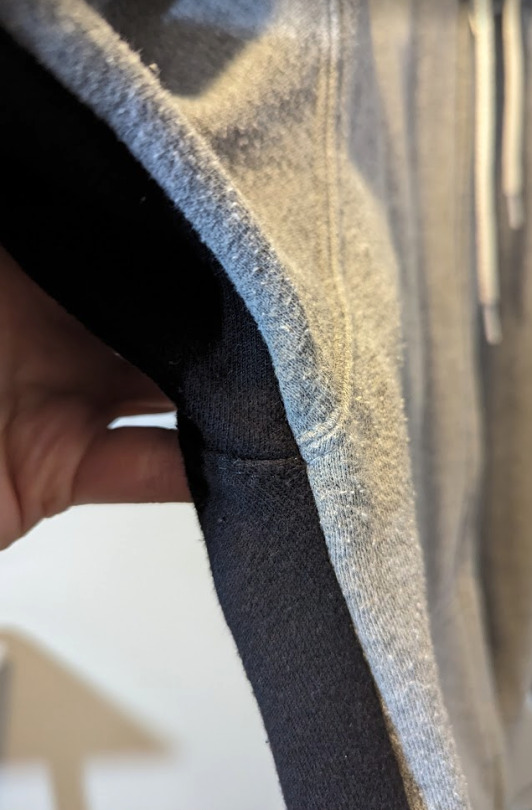
(Pay attention to your pits, to avoid getting down in the dumps.)
Time to serge! You can squinch and fudge the seams a little as you serge to make them line up a little better. Just don't pull or yank on them much, or your knits will be forever wonky.
Here's what it looks like on the inside:
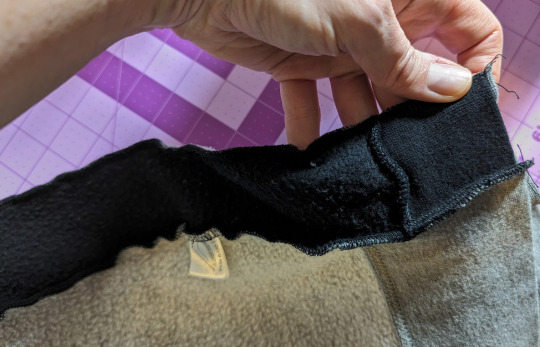
I hope this is helpful to others and you get more wears from things you love! If you need to find a hoodie or sweatshirt to sacrifice, hit up a thrift store. Just be sure to bring your hoodie with you as you shop, so you get one that is almost exactly the same length from hem to hem.
90 notes
·
View notes
Text
And… it’s done!
Took just over a week and the seam ripper got a workout but the Dark Eyes coat mark II is finished:




I had to make a few more adjustments/corrections as I went along:
The day after I set in the sleeves I noticed that the right shoulder dart was slightly too far forwards, which meant the sleeve head and shoulder pad had to come out so I could unpick the top of the seam and move it to the right place, something that helpfully removed the one little tuck I’d ended up with at the same time. Unpicking resulted in the fabric tearing so I had to take some extra on the seam when I restitched it, but this actually hid some of the holes from where I’d taken out the topstitching the day before which was a plus so I won’t complain! I also took the sleeves up by 3/4 of an inch when they proved too long even for someone with gibbon arms, an adjustment I must have made before but didn’t make a note of on the pattern.
Because I’m never satisfied I changed the collar again, rounding the ends slightly as it still looked too pointed. It was too high as well but I think I may have taken a bit too much off when I cut it down; not much I can do about it now. After I’d attached everything and topstitched I realised that it wasn’t meeting the lapel on the left side by about a centimetre which meant yet more unpicking to put it right. The edges aren’t sitting completely flat, something that’s annoying but that’s my fault for not rolling them over far enough when doing the topstitching.
The front edges were sticking out at an angle towards the bottom so I took some more off the seam to level them out.
When I made my first version, not knowing what the lining looked like I used up some ladybird satin I had left from a coat I’d made a few weeks before but this time I went for plain navy lining fabric which I think is probably more accurate (I could be wrong, of course; for all I know Paul’s hiding a funky lining in there. I know I would!):

I thought I’d put some photos of the two versions side by side so you can see the differences. The major changes were: returning the back side panels and creating the belt; shortening and shaping the collar; adding the pocket detail and the false bound holes behind the second row of buttons; topstitching round all eight buttonholes. I also felt when wearing it that the first coat was too short so I increased the length by a couple of inches. With hindsight I wish I’d narrowed the lapels a bit as they’re a lot wider than the collar but by the time I noticed it was too late to change as I’d already made the bound buttonholes. Never mind!
For comparison, old coat on the left, new on the right:










Overall, I’m really pleased with the way it’s turned out. It looks much more like the original, which is what I wanted, and though there may be tweaks I’d make if I was able I always feel that way; I’m never 100% happy with anything I make as I can always see room for improvement.
Obligatory dodgy mirror selfies to finish; I’ll try and get some better pics if I manage to wear it out somewhere in the next few weeks. You’ll probably have noticed that my version buttons up the opposite way round and that’s because - apart from the frock coat where it didn’t matter - I’ve never worked with mens’ patterns and changing the crossover would just confuse me. The shirt and waistcoat for my NotD cosplay both button this way and I wear my watch chain on the other side as well; I think that’s probably partly what Paul was referring to when he said upon seeing me in May that it was like looking in a mirror!


#i had sore fingers from sewing the hem and the buttons#it’s not easy pushing a needle through faux leather#i could have done with one of those pads sailmakers used to wear on their hands#but it’s done and i’m happy#sfs’s adventures in sewing#vogue pea jacket hack#doctor who#eighth doctor#8th doctor#dark eyes#sewing#cosplay
42 notes
·
View notes
Text
[Infomercial voice]
You there! Human owner of clothing!
Do you have a zipper that simply won't stay up? Are your pants unwearable because of this twist of fate?
Worry no more! A simple ring of metal is all you need! Put the zip back in your zipper and keep the barn door closed with this ingenious invention.
First, affix the ring of metal to the zipper pull. Next, place yourself in the pants and pull the zipper up. Then loop the ring of metal over the button of your pants. Finally, button your pants.
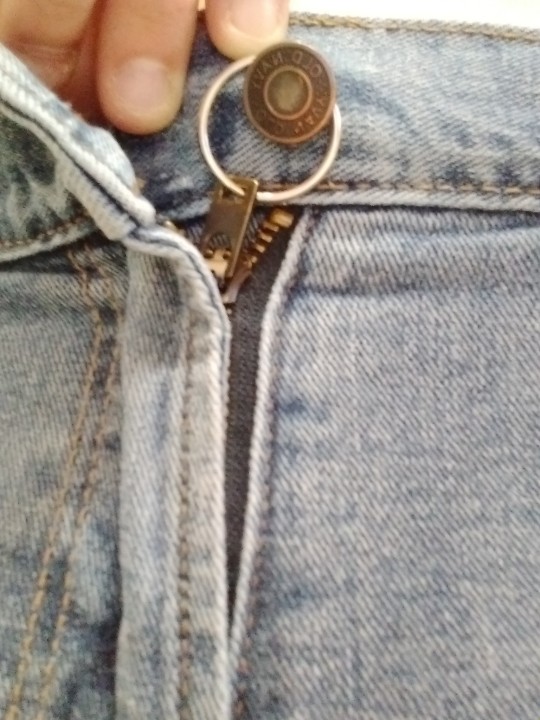
Potential alternatives to the ring of metal are notecard clip rings, D-rings, a bit of chain, any wire available, hair ties, ribbon, twine, yarn, embroidery thread, or anything else imaginable.
Go forth! Be free! And wear those pants!
#mending#life hack#diy#zipper#solarpunk#sewing#it's not waste until you waste it#thrifting#crafts#fixing#repair
94 notes
·
View notes
Text
I got a ton of new followers recently so not all of you know my favorite sewing machine hack
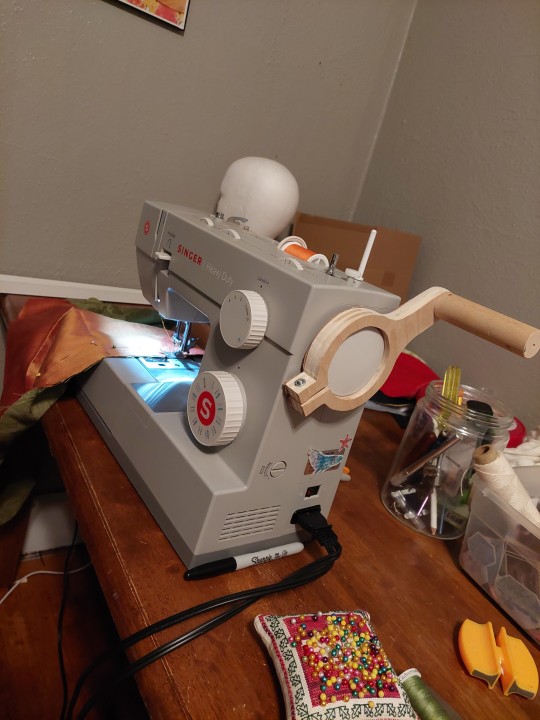
Handsewing too slow and uneven? Project too fiddly for machine speed? Need to constantly adjust needle placement but want to keep your wrists? Enter the Hand Crank. A friend made it out of wood but I bet you could 3d print one of these bad boys no problem.
When I was living off my sewing it literally saved my wrists.
486 notes
·
View notes
Text
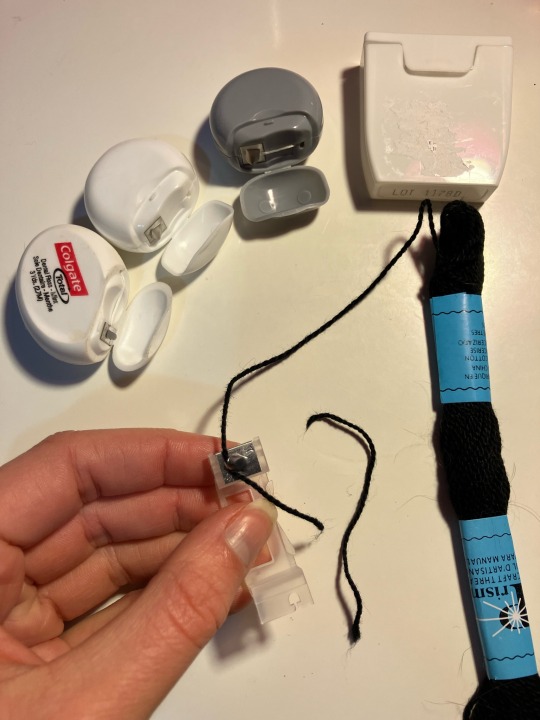
Ingenious hack I just came up with
Use the cutter on floss dispensers to cut string/thread quickly without bulky scissors
40 notes
·
View notes
Text


Ocular theatre (above) (2024) , found velvet paper and ink on paper with sewing machine thread.
Concrete ideas and outline formatting (below) (2024) , Fabriano paper, construction paper, ink, packing tape, Posca marker, and sewing machine thread.
#collage#kollaj#sarah van sloten#art#artists on tumblr#women artists#female artists#contemporary art#expanded painting#drawing#collages#collaging#found paper#sewing machine hacks#sewing on paper
9 notes
·
View notes